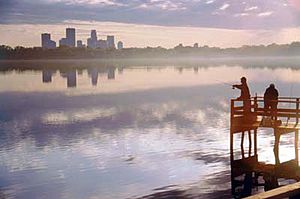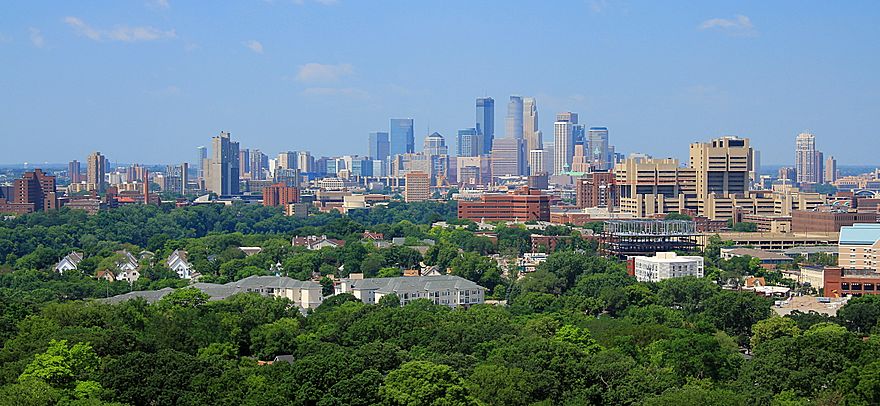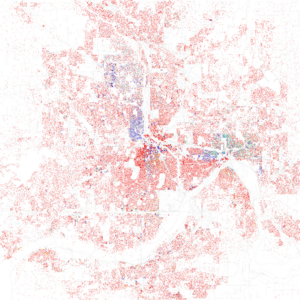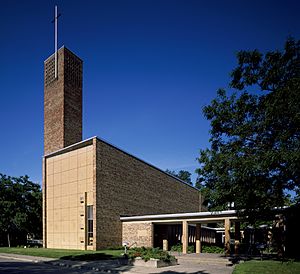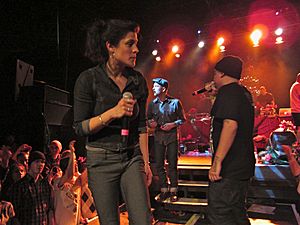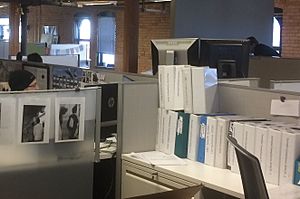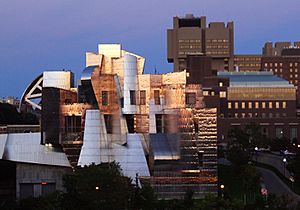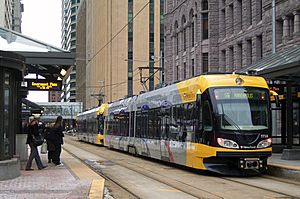Minneapolis facts for kids
Quick facts for kids
Minneapolis, Minnesota
|
|||
|---|---|---|---|
|
City
|
|||
| City of Minneapolis | |||

Clockwise from top left: Downtown Minneapolis at night; U.S. Bank Stadium; skyline from Lake Nokomis; Minneapolis skyline; and Minnehaha Falls
|
|||
|
|||
| Etymology: Dakota word mni ('water') with Greek polis ('city') | |||
| Nickname(s):
"City of Lakes", "Mill City", "Twin Cities" (with Saint Paul), "Mini Apple"
|
|||
| Motto(s):
En Avant (French: 'Forward')
|
|||
| Country | |||
| State | |||
| County | Hennepin | ||
| Incorporated | 1867 | ||
| Founded by | John H. Stevens and Franklin Steele | ||
| Government | |||
| • Type | Mayor-council (strong mayor) | ||
| • Body | Minneapolis City Council | ||
| Area | |||
| • City | 57.51 sq mi (148.95 km2) | ||
| • Land | 54.00 sq mi (139.86 km2) | ||
| • Water | 3.51 sq mi (9.09 km2) | ||
| Elevation | 830 ft (264 m) | ||
| Population
(2020)
|
|||
| • City | 429,954 | ||
| • Rank | 46th in the United States 1st in Minnesota |
||
| • Density | 7,962.11/sq mi (3,074.17/km2) | ||
| • Metro | 3,690,261 (16th) | ||
| Demonym(s) | Minneapolitan | ||
| Time zone | UTC–6 (CST) | ||
| • Summer (DST) | UTC–5 (CDT) | ||
| ZIP Codes |
55401-55419, 55423, 55429-55430, 55450, 55454-55455
|
||
| Area code(s) | 612 | ||
| FIPS code | 27-43000 | ||
| GNIS feature ID | 0655030 | ||
| Major airport | Minneapolis–Saint Paul International Airport | ||
| Interstates | |||
| U.S. Routes | |||
| State Highways | |||
| Public transportation | Metro Transit | ||
Minneapolis is a city in the U.S. state of Minnesota and the county seat of Hennepin County. Abundant in water, with thirteen lakes, wetlands, the Mississippi River, creeks and waterfalls, Minneapolis had its origins in timber and as the flour milling capital of the world. It lies along both banks of the Mississippi River and adjoins Saint Paul, the state capital of Minnesota.
The city, inhabited by Dakota people prior to European settlement, got its start due to the construction of Fort Snelling in 1819, eventually spurring growth along Saint Anthony Falls. With 429,954 inhabitants as of 2020, Minneapolis is the most populous city in the state and the 46th most populous city in the nation. Minneapolis, Saint Paul, and the surrounding area are collectively known as the Twin Cities.
Minneapolis has one of the nation's best park systems. Many of these parks are connected by the Grand Rounds National Scenic Byway. Biking and walking trails, some of which follow old railroad lines, run through many parts of the city, such as the historic Mill District by Saint Anthony Falls and around the lakes of the Lowry Hill area. Minneapolis has cold, snowy winters and hot, humid summers. Home to some large companies, Minneapolis is the birthplace of General Mills, Pillsbury, and the Target Corporation. The city is home to the Guthrie Theater as well as the First Avenue nightclub. Minneapolis hosts four professional sports teams.
The University of Minnesota main campus is for the most part in Minneapolis, as are some other postsecondary institutions. Part of the city is served by a light rail system. The city has several first rate hospitals, according to recent rankings.
Minneapolis has been a Minnesota Democratic-Farmer-Labor Party (DFL) stronghold for 50 years. The city uses a mayor council government system. Jacob Frey (DFL) has been mayor since 2018. In May 2020, Derek Chauvin, a White officer of the Minneapolis Police Department, murdered George Floyd, a Black man. The resulting global protests put Minneapolis and racism in the national and international spotlights.
Contents
History
Sioux natives, city founded

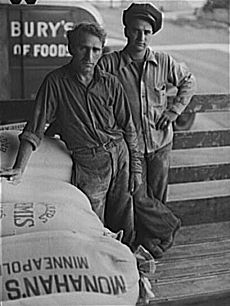
Dakota Sioux had long been the region's sole residents when French explorers arrived around 1680. For a time relations were based on fur trading. Gradually more European-American settlers arrived, competing for game and other resources with the Dakota.
In the early 19th century, the United States acquired this territory from France. It gradually established posts here. Fort Snelling was built in 1819 by the United States Army, and it attracted traders, settlers and merchants, spurring growth in the area. The United States government pressed the Mdewakanton band of the Dakota to sell their land, allowing people arriving from the East to settle here. The Minnesota Territorial Legislature authorized present-day Minneapolis as a town in 1856 on the Mississippi's west bank. Minneapolis was incorporated as a city in 1867, the year rail service began between Minneapolis and Chicago. It later joined with the east-bank city of St. Anthony in 1872.
Waterpower; lumber and flour milling
Minneapolis developed around Saint Anthony Falls, the highest waterfall on the Mississippi River and a source of power for its early industry. Forests in northern Minnesota were a valuable resource for the lumber industry, which operated seventeen sawmills on power from the waterfall. By 1871, the west river bank had twenty-three businesses, including flour mills, woolen mills, iron works, a railroad machine shop, and mills for cotton, paper, sashes, and planing wood. Due to the occupational hazards of milling, six local sources of artificial limbs were competing in the prosthetics business by the 1890s. The farmers of the Great Plains grew grain that was shipped by rail to the city's thirty-four flour mills. Millers have used hydropower elsewhere since the 1st century B.C., but the results in Minneapolis between 1880 and 1930 were so remarkable the city has been described as "the greatest direct-drive waterpower center the world has ever seen."
A father of modern milling in America and founder of what became General Mills, Cadwallader C. Washburn converted his business from gristmills to truly revolutionary technology, including "gradual reduction" processing by steel and porcelain roller mills capable of producing premium-quality pure white flour very quickly. Some ideas were developed by William Dixon Gray and some acquired through industrial espionage from the Hungarians by William de la Barre. Charles A. Pillsbury and C.A. Pillsbury Company across the river were barely a step behind, hiring Washburn employees to immediately use the new methods. The hard red spring wheat that grows in Minnesota became valuable ($.50 profit per barrel in 1871 increased to $4.50 in 1874,) and Minnesota "patent" flour was recognized at the time as the best in the world.
Not until later did consumers discover the value in the bran (which contains wheat's vitamins, minerals and fiber) that "Minneapolis... millers routinely dumped" into the Mississippi. Millers cultivated relationships with academic scientists especially at the University of Minnesota. Those scientists backed them politically on many issues, for example during the early 20th century, when health advocates in the nascent field of nutrition criticized the flour "bleaching" process. At peak production, a single mill at Washburn-Crosby made enough flour for 12 million loaves of bread each day, and by 1900, 14.1 percent of America's grain was milled in Minneapolis. Further, by 1895 through the efforts of silent partner William Hood Dunwoody, Washburn-Crosby exported four million barrels of flour a year to the United Kingdom, and when exports reached their peak in 1900, about one third of all flour milled in Minneapolis was shipped overseas.
Corruption, social movements, urban renewal
Known initially as a kindly physician, Doc Ames led the city into corruption during four terms as mayor just before 1900. The gangster Kid Cann was famous for bribery and intimidation during the 1930s and 1940s. The city made dramatic changes to rectify discrimination as early as 1886 when Martha Ripley founded Maternity Hospital for both married and unmarried mothers.
When the country's fortunes turned during the Great Depression, the violent Teamsters Strike of 1934 resulted in laws acknowledging workers' rights. A lifelong civil rights activist and union supporter, mayor Hubert Humphrey helped the city establish fair employment practices and a human relations council that interceded on behalf of minorities by 1946. In the 1950s, about 1.6% of the population of Minneapolis was nonwhite. Minneapolis contended with white supremacy, participated in desegregation and the African-American civil rights movement, and in 1968 was the birthplace of the American Indian Movement.
Minneapolis was a "particularly virulent" site of anti-semitism until 1950. A hate group known as the Silver Legion of America, or Silver Shirts, recruited members in the city and held meetings there around 1936 to 1938. The Jewish Free Employment Bureau tried to help victims of economic discrimination, with limited success. In 1938, the Jewish Community Relations Council of Minnesota and the Dakotas was established to combat rising anti-semitism, fighting against hate-filled leaflets and anti-Jewish remarks, while also attempting to expose discrimination by real estate agents and employers who attempted to subvert anti-discrimination laws. After years of discrimination towards Jewish doctors, the Jewish community raised funds to create the Mount Sinai Hospital, which opened in 1951. It was the first private non-sectarian hospital in the community to accept members of minority races on its medical staff.
During the 1950s and 1960s, as part of urban renewal, the city razed about 200 buildings across 25 city blocks (roughly 40% of downtown), destroying the Gateway District and many buildings with notable architecture, including the Metropolitan Building. Efforts to save the building failed but are credited with sparking interest in (but not always succeeding in) historic preservation in the state.
Geography and climate
The history and economic growth of Minneapolis are tied to water, the city's defining physical characteristic, which was brought to the region during the last ice age ten thousand years ago. Ice blocks deposited in valleys by retreating glaciers created the lakes of Minneapolis. Fed by a receding glacier and Lake Agassiz, torrents of water from a glacial river cut the Mississippi riverbed and created the river's only waterfall, Saint Anthony Falls, important to the early settlers of Minneapolis.
Lying on an artesian aquifer and flat terrain, Minneapolis has a total area of 58.4 square miles (151.3 km2) and of this 6% is water. Water supply is managed by four watershed districts that correspond to the Mississippi and the city's three creeks. Twelve lakes, three large ponds, and five unnamed wetlands are within Minneapolis.
The city center is located at 45° N latitude. The city's lowest elevation of 686 feet (209 m) is near where Minnehaha Creek meets the Mississippi River. The site of the Prospect Park Water Tower is often cited as the city's highest point and a placard in Deming Heights Park denotes the highest elevation. A spot at 974 feet (297 m) in or near Waite Park in Northeast Minneapolis, however, is corroborated by Google Earth as the highest ground.
Cityscape
Climate
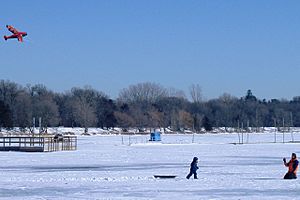
Minneapolis has a hot-summer humid continental climate zone (Dfa in the Köppen climate classification), typical of southern parts of the Upper Midwest, and is situated in USDA plant hardiness zone 4b, on the border of 5a. As is typical in a continental climate, the difference between average temperatures in the coldest winter month and the warmest summer month is great: 60.1 °F (33.4 °C).
According to the NOAA, Minneapolis's annual average for sunshine duration is 58%.
The city experiences a full range of precipitation and related weather events, including snow, sleet, ice, rain, thunderstorms, and fog. The highest recorded temperature was 108 °F (42 °C) in July 1936 while the lowest was −41 °F (−41 °C) in January 1888. The snowiest winter of record was 1983–84, when 8.2 feet or 98.4 inches (250 cm) of snow fell, and the least snowy winter was 1890-91, when only 11.1 inches (28 cm) fell.
| Climate data for Minneapolis/St. Paul International Airport (1981–2010 normals, extremes 1871–present) | |||||||||||||
|---|---|---|---|---|---|---|---|---|---|---|---|---|---|
| Month | Jan | Feb | Mar | Apr | May | Jun | Jul | Aug | Sep | Oct | Nov | Dec | Year |
| Record high °F (°C) | 58 (14) |
64 (18) |
83 (28) |
95 (35) |
106 (41) |
104 (40) |
108 (42) |
103 (39) |
104 (40) |
90 (32) |
77 (25) |
68 (20) |
108 (42) |
| Mean maximum °F (°C) | 43.1 (6.2) |
47.3 (8.5) |
65.9 (18.8) |
80.1 (26.7) |
87.9 (31.1) |
93.3 (34.1) |
94.8 (34.9) |
92.4 (33.6) |
87.9 (31.1) |
79.1 (26.2) |
61.6 (16.4) |
45.5 (7.5) |
96.6 (35.9) |
| Average high °F (°C) | 23.7 (−4.6) |
28.9 (−1.7) |
41.3 (5.2) |
57.8 (14.3) |
69.4 (20.8) |
78.8 (26.0) |
83.4 (28.6) |
80.5 (26.9) |
71.7 (22.1) |
58.0 (14.4) |
41.2 (5.1) |
27.1 (−2.7) |
55.2 (12.9) |
| Average low °F (°C) | 7.5 (−13.6) |
12.8 (−10.7) |
24.3 (−4.3) |
37.2 (2.9) |
48.9 (9.4) |
58.8 (14.9) |
64.1 (17.8) |
61.8 (16.6) |
52.4 (11.3) |
39.7 (4.3) |
26.2 (−3.2) |
12.3 (−10.9) |
37.2 (2.9) |
| Mean minimum °F (°C) | −15 (−26) |
−9.4 (−23.0) |
3.6 (−15.8) |
21.6 (−5.8) |
34.9 (1.6) |
45.0 (7.2) |
53.2 (11.8) |
50.7 (10.4) |
36.4 (2.4) |
25.3 (−3.7) |
7.6 (−13.6) |
−10 (−23) |
−18.9 (−28.3) |
| Record low °F (°C) | −41 (−41) |
−33 (−36) |
−32 (−36) |
2 (−17) |
18 (−8) |
34 (1) |
43 (6) |
39 (4) |
26 (−3) |
10 (−12) |
−25 (−32) |
−39 (−39) |
−41 (−41) |
| Average precipitation inches (mm) | 0.90 (23) |
0.77 (20) |
1.89 (48) |
2.66 (68) |
3.36 (85) |
4.25 (108) |
4.04 (103) |
4.30 (109) |
3.08 (78) |
2.43 (62) |
1.77 (45) |
1.16 (29) |
30.61 (778) |
| Average snowfall inches (cm) | 12.2 (31) |
7.7 (20) |
10.3 (26) |
2.4 (6.1) |
trace | 0 (0) |
0 (0) |
0 (0) |
trace | 0.6 (1.5) |
9.3 (24) |
11.9 (30) |
54.4 (138) |
| Average precipitation days (≥ 0.01 in) | 8.9 | 7.4 | 9.3 | 10.7 | 11.5 | 11.3 | 10.2 | 9.7 | 9.8 | 9.2 | 8.7 | 9.8 | 116.5 |
| Average snowy days (≥ 0.1 in) | 8.4 | 6.8 | 5.4 | 2.0 | 0.1 | 0 | 0 | 0 | 0 | 0.6 | 5.2 | 9.3 | 37.8 |
| Average relative humidity (%) | 69.9 | 69.5 | 67.4 | 60.3 | 60.4 | 63.8 | 64.8 | 67.9 | 70.7 | 68.3 | 72.6 | 74.1 | 67.5 |
| Mean monthly sunshine hours | 156.7 | 178.3 | 217.5 | 242.1 | 295.2 | 321.9 | 350.5 | 307.2 | 233.2 | 181.0 | 112.8 | 114.3 | 2,710.7 |
| Percent possible sunshine | 55 | 61 | 59 | 60 | 64 | 69 | 74 | 71 | 62 | 53 | 39 | 42 | 59 |
| Source 1: NOAA (relative humidity and sun 1961−1990) | |||||||||||||
| Source 2: The Weather Channel | |||||||||||||
Demographics
| Racial composition | 2020 | 2010 | 1990 | 1970 | 1950 |
|---|---|---|---|---|---|
| White (non-Hispanic) | 58.0% | 60.3% | 77.5% | 92.8% | n/a |
| Black or African American (non-Hispanic) | 18.9% | 18.3% | 13.0% | 4.4% | 1.3% |
| Hispanic or Latino | 10.4% | 10.5% | 2.1% | 0.9% | n/a |
| Asian (non-Hispanic) | 5.8% | 5.6% | 4.3% | 0.4% | 0.2% |
| Other race (non-Hispanic) | 0.5% | 0.3% | n/a | n/a | n/a |
| Two or more races (non-Hispanic) | 5.2% | 3.4% | n/a | n/a | n/a |
| Historical population | |||
|---|---|---|---|
| Census | Pop. | %± | |
| 1860 | 5,809 | — | |
| 1870 | 13,066 | 124.9% | |
| 1880 | 46,887 | 258.8% | |
| 1890 | 164,738 | 251.4% | |
| 1900 | 202,718 | 23.1% | |
| 1910 | 301,408 | 48.7% | |
| 1920 | 380,582 | 26.3% | |
| 1930 | 464,356 | 22.0% | |
| 1940 | 492,370 | 6.0% | |
| 1950 | 521,718 | 6.0% | |
| 1960 | 482,872 | −7.4% | |
| 1970 | 434,400 | −10.0% | |
| 1980 | 370,951 | −14.6% | |
| 1990 | 368,383 | −0.7% | |
| 2000 | 382,618 | 3.9% | |
| 2010 | 382,578 | 0.0% | |
| 2020 | 429,954 | 12.4% | |
| US Decennial Census | |||
Dakota tribes, mostly the Mdewakanton, were permanent settlers near their sacred site St. Anthony Falls. New settlers arrived during the 1850s and 1860s from New England, New York, Bohemia and Canada, and, during the mid-1860s, immigrants from Finland, Sweden, Norway and Denmark began to call Minneapolis home. Migrant workers from Mexico and Latin America interspersed. Other immigrants came from Germany, Poland, Italy, and Greece. Central European immigrants settled in the Northeast neighborhood, still known for its Czech and Polish cultural heritage. Jews from Central and Eastern Europe, and Russia began arriving in the 1880s and settled primarily on the north side before moving to western suburbs in the 1950s and 1960s.
Two groups came for a short while during US government relocations: Japanese during the 1940s, and Native Americans during the 1950s. In 2013, Asians were the state's fastest growing population. Chinese, Japanese and Filipinos came in the 1970s, Hmong, Lao, Cambodian and Vietnamese in the 1970s and 1980s, and people from Tibet, Burma and Thailand came in the 1990s and 2000s. The population of people from India doubled by 2010. After the Rust Belt economy declined during the early 1980s, Minnesota's Black population nearly tripled in less than two decades, a large fraction hailing from cities such as Chicago and Gary, Indiana. Black migrants were drawn to Minneapolis (and the Greater Twin Cities) by its abundance of jobs, good schools, and relatively safe neighborhoods. Beginning in the 1990s, a sizable Latino population arrived, along with immigrants from the Horn of Africa, especially Somalia, however immigration of fourteen hundred Somalis in 2016, slowed to forty eight in 2018 under President Trump. As of 2019, more than 20,000 Somalis call the city home. In 2015, Brookings characterized Minneapolis as a re-emerging immigrant gateway with about 10 percent foreign-born residents. As of 2019, African Americans make up about one fifth of the city's population.
The US Census Bureau estimates the population of Minneapolis to be 429,606 as of 2019, a 12.3 percent increase since the 2010 census. The population grew until 1950, when the census peaked at 521,718, and then declined until about 1990 as people moved to the suburbs.
Gallup reported in 2015 that the Twin Cities had an estimated LGBT adult population of 3.6%, roughly the same as the national average, and about 38th among the 50 largest metropolitan areas. In line with other cities, Human Rights Campaign gave Minneapolis its highest possible score in 2019.
A 2015 report found that racial and ethnic minorities in the city lagged behind White counterparts in education, with 15 percent of Blacks and 13 percent of Hispanics holding bachelor's degrees compared to 42 percent of the White population. While the standard of living is rising with incomes among the highest in the Midwest, in 2015 the median household income among minorities was below that of Whites by over $17,000 and the poverty rate gap between Blacks and Whites was the highest in the US. A 2020 study found little change in economic racial inequality, with Minnesota ranking only above the neighboring state of Wisconsin and equal to the states of Iowa, Louisiana, and New Mexico.
Racial conflicts
Minneapolis has a long history of structural racism and the city has some of the United States' largest racial disparities in housing, income, healthcare, and education.
Some historians have claimed that at various times, some White Minneapolitans have used discrimination based on race against the city's non-White residents. As White settlers displaced the indigenous population during the 19th century, they claimed the city's land. In 1910 when less than 1% of Minneapolis residents were non-White, the city was fairly well integrated, but discrimination increased when flour milling moved east and the economy declined. Developers created racial covenants on real estate deeds that excluded people with Black and Asian backgrounds from fair housing and accumulating equity and wealth. Redlining by the Federal Housing Administration in the 1940s cemented racial restriction on desirable properties bordering the Grand Rounds.
Commentators and observers have written about historic racism and socioeconomic disparities in the city. Kirsten Delegard of Mapping Prejudice explained that disparities today evolved from White people asserting control of the city's land. William D. Green of Augsburg University said that in Minneapolis the races live in parallel universes.
Religion
| Religion in Minneapolis (2014) | ||||
|---|---|---|---|---|
| Religion | Percent | |||
| Protestant | 46% | |||
| No affiliation | 23% | |||
| Catholic | 21% | |||
| Other | 5% | |||
| Mormon | 1% | |||
The Dakota people, the original inhabitants of the area where Minneapolis now stands, believed in the Great Spirit and were surprised that not all European settlers were religious. More than 50 denominations and religions have been established with a Christian majority. Those who arrived from New England were for the most part Protestants, Quakers, and Universalists. The oldest continuously used church, Our Lady of Lourdes Catholic Church, was built in 1856 by Universalists and soon afterward was acquired by a French Catholic congregation. The first Jewish congregation was formed in 1878 as Shaarai Tov, and built Temple Israel in 1928. St. Mary's Orthodox Cathedral was founded in 1887, opened a missionary school, and created the first Russian Orthodox seminary in the US. Edwin Hawley Hewitt designed both St. Mark's Episcopal Cathedral and Hennepin Avenue United Methodist Church just south of downtown. The first basilica in the US, and co-cathedral of the Roman Catholic Archdiocese of Saint Paul and Minneapolis, the Basilica of Saint Mary was named by Pope Pius XI in 1926.
The Billy Graham Evangelistic Association was headquartered in Minneapolis from the late 1940s into the early 2000s. Jim Bakker and Tammy Faye met while attending the Pentecostal North Central University and began a television ministry that by the 1980s reached 13.5 million households. As of 2012, Mount Olivet Lutheran Church in southwest Minneapolis was the nation's second-largest Lutheran congregation, with about 6,000 attendees. Christ Church Lutheran in the Longfellow neighborhood, designed by Eliel Saarinen with an education building by his son Eero Saarinen, is a National Historic Landmark.
During the 1950s, members of the Nation of Islam created a temple in north Minneapolis, and the first Muslim mosque was built in 1967. In 1972 a relief agency resettled the first Shi'a Muslim family from Uganda in the Twin Cities. Thousands of Somalis who live in the city are primarily Sunni Muslim. The city has about 20 Buddhist and meditation centers. Atheists For Human Rights has its headquarters in the Shingle Creek neighborhood in a geodesic dome. Minneapolis has a body of Ordo Templi Orientis.
Culture
Minneapolis' cultural organizations draw creative people and audiences to the city for theater, visual art, writing and music. The community's diverse population also continues to manage a long tradition of charitable support through progressive public social programs, VOLAGs and volunteering, as well as through private and corporate philanthropy.
Visual arts

The Walker Art Center, one of the five largest modern art museums in the U.S., sits atop Lowry Hill, near the downtown area. The size of the Center was doubled with an addition in 2005 by Herzog & de Meuron, and expanded with the conversion of a 15 acres (6.1 ha) park designed by Michel Desvigne, located across the street from the Minneapolis Sculpture Garden.
The Minneapolis Institute of Art, designed by McKim, Mead & White in 1915 in south central Minneapolis, is the largest art museum in the city, with 100,000 pieces in its permanent collection. New wings, designed by Kenzo Tange and Michael Graves, opened in 1974 and 2006, respectively, for contemporary and modern works, as well as more gallery space.
The Weisman Art Museum, designed by Frank Gehry for the University of Minnesota, opened in 1993. An addition which doubled the size of the galleries, also designed by Gehry, opened in 2011. The Museum of Russian Art opened in a restored church in 2005 and exhibits a collection of 20th-century Russian art as well as lecture series, seminars, social functions and other special events.
USA Today voted the Northeast Minneapolis Arts District as the nation's best art district in 2015, citing 400 independent artists, a center at the Northrup King Building, and recurring annual events like Art-A-Whirl every spring, and the Fine Arts Show Art Attack and Casket Arts Quad's Cache open studio events in November.
Theater and performing arts
Minneapolis has been a cultural center for theatrical performances since the mid 1800s. Early theaters included the Pence Opera House, the Academy of Music, the Grand Opera House, the Lyceum, and later the Metropolitan Opera House, which opened in 1894.
The city is second only to New York City in terms of live theater per capita and is the third-largest theater market in the U.S., after New York City and Chicago. Theater companies and troupes such as the Illusion, Jungle, Mixed Blood, Penumbra, Mu Performing Arts, Bedlam Theatre, HUGE Improv Theater, the Brave New Workshop, the Minnesota Dance Theatre, Red Eye Theater, Skewed Visions, Theater Latté Da, In the Heart of the Beast Puppet and Mask Theatre, Lundstrum Center for the Performing Arts and the Children's Theatre Company are based in Minneapolis.
The Guthrie Theater, the area's largest theater company, occupies a three-stage complex overlooking the Mississippi, designed by French architect Jean Nouvel. The company was founded in 1963 as a prototype alternative to Broadway, and it produces a wide variety of shows throughout the year. Minneapolis purchased and renovated the Orpheum, State, and Pantages Theatres vaudeville and film houses on Hennepin Avenue, which is now used for concerts and plays. A fourth renovated theater, the former Shubert, joined with the Hennepin Center for the Arts to become the Cowles Center for Dance and the Performing Arts, home to more than one dozen performing arts groups. The city is home to Minnesota Fringe Festival, the largest nonjuried performing arts festival in the U.S.
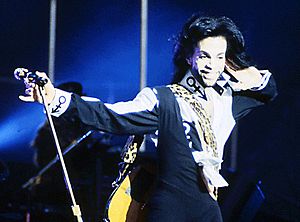
Music
The son of a jazz musician and a singer, Prince was born in Minneapolis, lived in the area most of his life, and became Rolling Stone's 27th greatest artist of the rock era. With fellow local musicians, many of whom recorded at Twin/Tone Records, he helped make First Avenue and the 7th Street Entry prominent venues for both artists and audiences. Other prominent artists from Minneapolis include Hüsker Dü and The Replacements—who were pivotal in the U.S. alternative rock boom during the 1990s. The Replacements' frontman, Paul Westerberg, developed a successful solo career, as did Hüsker Dü's Bob Mould.
The Minnesota Orchestra plays classical and popular music at Orchestra Hall under music director Osmo Vänskä—a critic writing for The New Yorker in 2010 described it as "the greatest orchestra in the world." In 2013, the orchestra received a Grammy nomination for its recording of "Sibelius: Symphonies Nos. 2 & 5" and it won a Grammy Award in 2014 for "Sibelius: Symphonies Nos 1 & 4". Vänskä departed in 2013 when a labor dispute remained unresolved and forced the cancellation of concerts scheduled for Carnegie Hall. After a 15-month lockout, a contract settlement resulted in the return of the performers, including Vänskä, to Orchestra Hall in January 2014.
Tom Waits released two songs about the city, "Christmas Card from a Hooker in Minneapolis" (Blue Valentine (1978)) and "9th & Hennepin" (Rain Dogs (1985)), while Lucinda Williams recorded "Minneapolis" (World Without Tears (2003)). In 2008, the century-old MacPhail Center for Music opened a new facility designed by James Dayton.
Home to the MN Spoken Word Association and independent hip hop label Rhymesayers Entertainment, the city has garnered attention for rap, hip hop and its spoken word community. Underground Minnesota hip hop acts like Atmosphere and Manny Phesto frequently comment about the city and Minnesota in song lyrics.
Locally and internationally recognized Minneapolis electronic dance music artists include Woody McBride, Freddy Fresh (who walks a line with hip hop) and DVS1.
Literature
Minneapolis is the third-most literate city in the U.S. A center for printing and publishing, Minneapolis was the city in which Open Book, the largest literary and book arts center in the U.S., was founded. The Center consists of the Loft Literary Center, the Minnesota Center for Book Arts and Milkweed Editions (the latter is sometimes called the country's largest independent nonprofit literary publisher). The Center exhibits and teaches both contemporary art and traditional crafts of writing, papermaking, letterpress printing and bookbinding.
Charity
Philanthropy and charitable giving are part of the community. More than 40% of adults in the Minneapolis–Saint Paul area give time to volunteer work, the highest such percentage of any large metropolitan area in the United States. Catholic Charities USA is one of the largest providers of social services locally. The American Refugee Committee helps 2.5 million refugees and displaced persons in ten countries in Africa and Asia each year. In 2011, Target Corporation was #42 in a list of the best 100 corporate citizens in CR magazine for corporate responsibility officers. The oldest foundation in Minnesota, the Minneapolis Foundation invests and administers over nine hundred charitable funds and connects donors to nonprofit organizations. The metropolitan area gives 13% of its total charitable donations to the arts and culture. The majority of the estimated $1 billion recent expansion of arts facilities was contributed privately.
Cuisine
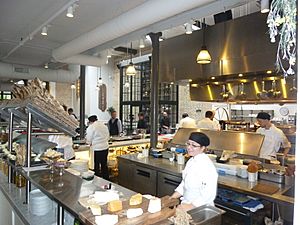
Minneapolis is home to award-winning restaurants and chefs. As of 2016, four Minneapolis-based chefs have won James Beard Foundation Awards: Alexander Roberts, Restaurant Alma; Isaac Becker, 112 Eatery; Paul Bergland, Bachelor Farmer; and Tim McKee, La Belle Vie. In 2014, seven chefs and restaurants in the area were named as semifinalists.
Julia Moskin wrote about New Nordic cuisine, chef Paul Berglund and the Bachelor Farmer, and the restaurants La Loma, Tilia, the Red Stag Supper Club, Fika and Haute Dish in The New York Times in 2012. She said Minneapolis chefs served trendy Nordic ingredients like root vegetables, fish roe, wild greens, venison, dried mushrooms, seaweed and cow's milk. Two months later, Bon Appétit featured the Bachelor Farmer, Piccolo, Saffron, Salty Tart, and Smack Shack/1029 Bar, writing about New Nordic cuisine and the Scandinavian heritage of Minneapolis. In 2012 Food & Wine magazine named Minneapolis the nation's best and best-priced new food city. In 2015, profiling chef Gavin Kaysen and Spoon and Stable, Saveur named Minneapolis "the next great American food city." Then, Food & Wine voted Spoon and Stable one of five 2015 restaurants of the year.
In 2015, Bon Appétit named Spoon and Stable, along with Hola Arepa and Heyday, three of the 50 best places in the U.S. for a meal. In 2015, Spoon and Stable was nominated for a James Beard Award for Best New Restaurant, and Shea, Inc., who designed the Spoon and Stable renovation, was nominated for Outstanding Restaurant Design. Jason DeRusha of WCCO-TV was nominated for his television segment, DeRusha Eats.
USA Today's reader's choice 10 Best decided that Minneapolis–Saint Paul was the Best Local Food Scene in 2015. Four fine dining restaurants closed during 2015 and 2016: La Belle Vie, Vincent, Brasserie Zentral, and Saffron. Food & Wine named Brewer's Table at Surly Brewing one of its ten 2016 restaurants of the year. Also in 2016, Food & Wine named Eat Street Social, Constantine, and Coup d'État three of the best cocktail bars in the U.S.
Parks and recreation
The Minneapolis park system has been called the best-designed, best-financed, and best-maintained in America. Foresight, donations and effort by community leaders enabled Horace Cleveland to create his finest landscape architecture, preserving geographical landmarks and linking them with boulevards and parkways. The city's Chain of Lakes, consisting of seven lakes and Minnehaha Creek, is connected by bike, running, and walking paths and used for swimming, fishing, picnics, boating, and ice skating. A parkway for cars, a bikeway for riders, and a walkway for pedestrians runs parallel along the 52 miles (84 km) route of the Grand Rounds National Scenic Byway.
Theodore Wirth is credited with the development of the parks system. Today, 16.6% of the city is parks and there are 770 square feet (72 m2) of parkland for each resident, ranked in 2008 as the most parkland per resident within cities of similar population densities. In its 2013 ParkScore ranking, The Trust for Public Land reported that Minneapolis had the best park system among the 50 most populous U.S. cities.
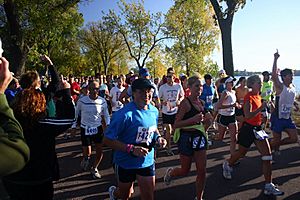
Parks are interlinked in many places and the Mississippi National River and Recreation Area connects regional parks and visitor centers. The country's oldest public wildflower garden, the Eloise Butler Wildflower Garden and Bird Sanctuary, is located within Theodore Wirth Park. Wirth Park is shared with Golden Valley and is about 60% the size of Central Park in New York City. Site of the 53-foot (16 m) Minnehaha Falls, Minnehaha Park is one of the city's oldest and most popular parks, receiving over 500,000 visitors each year. Henry Wadsworth Longfellow named Hiawatha's wife Minnehaha for the Minneapolis waterfall in The Song of Hiawatha, a bestselling and often-parodied 19th century poem.
Runner's World ranks the Twin Cities as America's sixth best city for runners. Team Ortho sponsors the Minneapolis Marathon, Half Marathon and 5K which began in 2009 with more than 1,500 starters. The Twin Cities Marathon run in Minneapolis and Saint Paul every October draws 250,000 spectators. The 26.2-mile (42.2 km) race is a Boston and USA Olympic Trials qualifier. The organizers sponsor three more races: a Kids Marathon, a 1-mile (1.6 km), and a 10-mile (16 km).
The American College of Sports Medicine ranked Minneapolis and its metropolitan area the nation's first, second, or third "fittest city" every year from 2008 to 2016, ranking it first from 2011 to 2013. In other sports, five golf courses are located within the city, with the nationally ranked Hazeltine National Golf Club and Interlachen Country Club in nearby suburbs. Minneapolis is home to more golfers per capita than any other major U.S. city. The state of Minnesota has the nation's highest number of bicyclists, sport fishermen, and snow skiers per capita. Hennepin County has the second-highest number of horses per capita in the U.S. While living in Minneapolis, Scott and Brennan Olson founded (and later sold) Rollerblade, the company that popularized the sport of inline skating.
Sister cities
Minneapolis has 12 sister cities, as per Sister Cities International:
 Bosaso (Somalia) since 2014
Bosaso (Somalia) since 2014 Najaf (Iraq) since 2009
Najaf (Iraq) since 2009 Cuernavaca (Mexico) since 2008
Cuernavaca (Mexico) since 2008 Uppsala (Sweden) since 2000
Uppsala (Sweden) since 2000 Eldoret (Kenya) since 2000
Eldoret (Kenya) since 2000 Harbin (PR China) since 1992
Harbin (PR China) since 1992 Tours (France) since 1991
Tours (France) since 1991 Novosibirsk (Russia) since 1988
Novosibirsk (Russia) since 1988 Ibaraki (Japan) since 1980
Ibaraki (Japan) since 1980 Kuopio (Finland) since 1972
Kuopio (Finland) since 1972 Santiago (Chile) since 1961
Santiago (Chile) since 1961
On the city's website, Winnipeg, Canada is listed as a sister city since 1973, but the two are not listed as sister cities in the organization's 2014 membership directory.
The city also has an informal connection with:
 Hiroshima, Japan
Hiroshima, Japan
Economy
| Top publicly traded Minneapolis companies for 2021 with city and US ranks Source: Fortune 500 |
|||||||
| Mpls | Corporation | US | Revenue (in millions) |
||||
| 1 | Target Corporation | 30 | $93,561 | ||||
| 2 | U.S. Bancorp | 113 | $25,241 | ||||
| 3 | Ameriprise Financial | 253 | $11,958 | ||||
| 4 | Xcel Energy | 272 | $11,526 | ||||
| 5 | Thrivent | 369 | $8,152.7 | ||||
| Top Minneapolis employers in 2020 Source: Twin Cities Business |
|||||||
| Rank | Company/Organization | ||||||
| 1 | Target Corporation | ||||||
| 2 | Hennepin Healthcare | ||||||
| 3 | Wells Fargo | ||||||
| 4 | Hennepin County | ||||||
| 5 | U.S. Bancorp | ||||||
| 6 | Ameriprise Financial | ||||||
| 7 | Xcel Energy | ||||||
| 8 | City of Minneapolis | ||||||
| 9 | RBC Wealth Management | ||||||
| 10 | Strategic Education | ||||||
As of 2020, Minneapolis–St. Paul area is the second largest economic center in the Midwest, behind Chicago. During the city's formative years, millers had to pay cash for wheat during the growing season and then hold it until it was needed for flour. This required large amounts of capital, which stimulated the local banking industry and made Minneapolis a major financial center. The economy of Minneapolis today is based in commerce, finance, rail and trucking services, health care, and industry. Smaller components are in publishing, milling, food processing, graphic arts, insurance, education, and high technology.
The Twin Cities metropolitan area has the seventh highest concentration of major corporate headquarters in the country as of 2021, and in 2020, four Fortune 500 corporations were headquartered within the city limits of Minneapolis. American companies with US offices in Minneapolis include Accenture, Bellisio Foods , Canadian Pacific, Coloplast, RBC and Voya Financial. In its 2018 survey based on the 2017 cost of living for expatriate executives, The Economist ranked Minneapolis the third-most expensive city of those surveyed in North America and 26th in the world.
As of 2020, the Minneapolis metropolitan area contributes $273 billion or 74% to the gross state product of Minnesota. Measured by gross metropolitan product per resident ($62,054), as of 2015, Minneapolis is the fifteenth richest city in the US. In 2011, the area's $199.6 billion gross metropolitan product and its per capita personal income ranked thirteenth in the US.
The Minneapolis Grain Exchange, founded in 1881, is still located near the riverfront and is the only exchange for hard red spring wheat futures and options. The Federal Reserve Bank of Minneapolis serves Minnesota, Montana, North and South Dakota, and parts of Wisconsin and Michigan, the smallest population of the twelve regional banks in the Federal Reserve System. Along with supporting consumers and the community, the bank executes monetary policy, regulates the banks in its territory, provides cash, and oversees electronic deposits.
Sports
| Team | Sport | League | Since | Venue (capacity) | Championships |
|---|---|---|---|---|---|
| Minnesota Lynx | Basketball | Women's National Basketball Association | 1999 | Target Center (18,798) | 2011, 2013, 2015, 2017 |
| Minnesota Timberwolves | Basketball | National Basketball Association | 1989 | Target Center (18,798) | |
| Minnesota Twins | Baseball | Major League Baseball | 1961 | Target Field (39,500) | 1987, 1991 |
| Minnesota Vikings | American football | National Football League | 1961 | U.S. Bank Stadium (66,655) | 1969 (NFL) |
Minneapolis is home to four professional sports teams. The Minnesota Vikings football team and the Minnesota Twins baseball team have played in the state since 1961. The Vikings were an NFL expansion team, and the Twins were formed when the Washington Senators relocated to Minnesota. The Twins won the World Series in 1987 and 1991 and have played at Target Field since 2010. The Vikings played in the Super Bowl following 1969, 1973, 1974, and 1976 seasons, losing all four games. The Minnesota Timberwolves brought NBA basketball back to Minneapolis in 1989, followed by the Minnesota Lynx in 1999. Both basketball teams play in the Target Center.
In recent years, the Lynx have been the most successful sports team in the city and a dominant force in the WNBA, reaching the WNBA Finals in 2011, 2012, 2013, 2015, 2016, and 2017 and winning in 2011, 2013, 2015 and 2017. The Lynx captains wore black shirts in 2016 in the wake of the killing of Philando Castile and Alton Sterling, among U.S. protests for social change by black athletes that began in 1968.
In addition to professional sports teams, Minneapolis is also home to the majority of the Minnesota Golden Gopher sports teams. The Gophers football team plays at Huntington Bank Stadium and has claimed seven national championships, in 1904, 1934, 1935, 1936, 1940, 1941, and 1960. The Gophers women's ice hockey team plays at Ridder Arena and is a six-time NCAA champion and seven-time national champion winning in 2000, 2004, 2005, 2012, 2013, 2015, and 2016. The Gophers men's ice hockey team plays at 3M Arena at Mariucci and has won five NCAA national championships, in 1974, 1976, 1979, 2002 and 2003. Both the men's basketball and women's basketball teams play at Williams Arena.
The 1,750,000-square-foot (163,000 m2) U.S. Bank Stadium was built for the Vikings for about $1.122 billion, with $348 million coming from the state of Minnesota and $150 million coming from the city of Minneapolis. Called "Minnesota's biggest-ever public works project," the stadium opened in 2016 with 66,000 seats, expandable to 70,000 for the 2018 Super Bowl. U.S. Bank Stadium also hosts indoor running and rollerblading nights, as well as concerts and events.
Major sporting events hosted by the city include baseball All-Star Games, World Series, Super Bowls, NCAA Division 1 men's and women's basketball Final Four, the AMA Motocross Championship, the X Games and the WNBA All-Star Game.
The Minnesota Wild of the NHL play at the Xcel Energy Center, and the MLS soccer team Minnesota United FC play at Allianz Field, both in Saint Paul. In other sports, six golf courses are located within city limits. While living in Minneapolis, Scott and Brennan Olson founded (and later sold) Rollerblade, the company that popularized the sport of inline skating.
Education
Primary and secondary education
Minneapolis Public Schools enroll over 35,000 students in public primary and secondary schools. The district administers about one hundred public schools including forty-five elementary schools, seven middle schools, seven high schools, eight special education schools, eight alternative schools, nineteen contract alternative schools, and five charter schools. With authority granted by the state legislature, the school board makes policy, selects the superintendent, and oversees the district's budget, curriculum, personnel, and facilities. In 2017, the graduation rate was 66 percent. Students speak over one hundred different languages at home and most school communications are printed in English, Hmong, Spanish, and Somali. Some students attend public schools in other school districts chosen by their families under Minnesota's open enrollment statute. Besides public schools, the city is home to more than twenty private schools and academies and about twenty additional charter schools.
Colleges and universities
Minneapolis's collegiate scene is dominated by the main campus of the University of Minnesota where more than 50,000 undergraduate, graduate, and professional students attend twenty colleges, schools, and institutes. The university offers free tuition to students from Minnesota families earning less than $50,000 per year. The graduate school programs with exceptional national rankings in 2020 (top five) were health care management, nursing, midwifery, pharmacy and clinical psychology. The university enjoys unusual constitutional autonomy, that exists in only three states, since 1851 when that provision was included in the state constitution.
Augsburg University, Minneapolis College of Art and Design, and North Central University are private four-year colleges. Minneapolis Community and Technical College and the private Dunwoody College of Technology provide career training. St. Mary's University of Minnesota has a Twin Cities campus for its graduate and professional programs. Two large principally online universities, Capella University and Walden University, are both headquartered in the city. The public four-year Metropolitan State University and the private four-year University of St. Thomas are among postsecondary institutions based elsewhere with campuses in Minneapolis.
Libraries
Founded by T. B. Walker in 1885, the Minneapolis Public Library merged with the Hennepin County Library system in 2008. The new downtown Central Library designed by César Pelli opened in 2006. Ten special collections hold over 25,000 books and resources for researchers, including the Minneapolis Collection and the Minneapolis Photo Collection. About 845,000 people have free library cards.
Infrastructure
Transportation
Minneapolis has two light rail lines and one commuter rail line. The Metro Blue Line connects the Mall of America and Minneapolis–Saint Paul International Airport in Bloomington to downtown and the Metro Green Line travels east from downtown through the University of Minnesota campus to downtown Saint Paul. Hundreds of homeless people nightly sought shelter on Green Line trains until overnight service was cut back in 2019 and rising crime on the light rail system led to discussion in the state legislature on how to best address the issue in 2020. An extension of the Green Line will connect downtown Minneapolis with the southwestern suburbs and is expected to open in 2023. An extension of the Blue Line to the northwest suburbs reentered the planning stages for a new route alignment in 2020. The 40-mile Northstar Commuter rail runs from Big Lake through the northern suburbs and terminates at the multi-modal transit station at Target Field using existing railroad tracks. Public transit ridership in the Twin Cities was 91.6 million in 2019, a three percent decline over the previous year which is part of a national trend in lower local bus ridership. Ridership on the Metro system remained steady or grew slightly.
In 2007, the Interstate 35W bridge over the Mississippi, at the time overloaded with three hundred tons of repair materials, collapsed, killing thirteen and injuring 145 people. The bridge was rebuilt in fourteen months. Only one-fourth of the country's structurally deficient bridges had been repaired ten years later.
Walk Score rated Minneapolis as having the 13th highest Walk Score and the highest Bike Score among cities with more than 200,000 people in the US in 2020. The Minneapolis Skyway System, 9.5 miles (15.3 km) of enclosed pedestrian bridges called skyways, link 80 city blocks downtown with second floor restaurants and retailers open weekdays. Bicycling named Minneapolis the 4th best bicycling city in 2018. Minneapolis has 82 miles (132 km) of trails for walking and biking. Off-street facilities include the Grand Rounds, Midtown Greenway, Little Earth Trail, Hiawatha LRT Trail, Kenilworth Trail, and Cedar Lake Trail. Bicycle sharing provider Nice Ride Minnesota planned expanded capacity in 2019.
Minneapolis–Saint Paul International Airport (MSP) serves 18 international, domestic, charter and regional carriers and is home base for Sun Country Airlines. As of 2019, it is also the second-largest hub for Delta Air Lines, which operates more flights out of MSP than any other airline. For terminals serving 25 to 40 million passengers, MSP was named the world's best airport for customer experience in North America in 2020 for the fourth consecutive year. Forbes named MSP the second best airport in North America, behind Detroit in 2019.
Utilities
"Ambassadors," identified by their blue and fluorescent green-yellow jackets, patrol daily a 120-block area downtown to greet and assist visitors, remove the trash, monitor property, and call the police when they are needed. The ambassador program is a public-private partnership with a $6.6 million annual budget paid for by a special downtown tax district.
Xcel Energy supplies electricity, CenterPoint Energy supplies gas, CenturyLink provides landline telephone service, and Comcast provides cable service. The city treats and distributes the water and charges a monthly solid waste fee for trash removal.
After each significant snowfall, called a snow emergency, the Minneapolis Public Works Street Division plows over 1,000 mi (1,610 km) of streets and 400 mi (640 km) of alleys—counting both sides, the distance between Minneapolis and Seattle and back. Ordinances govern parking on the plowing routes during these emergencies as well as snow shoveling.
Notable people
Images for kids
-
Spring art party, North Commons Park, Willard-Hay, one of the 83 neighborhoods of Minneapolis
-
Minneapolis Institute of Art has a collection of 90,000 objects spanning 20,000 years.
-
Recording artist Prince studied at Minnesota Dance Theatre through Minneapolis Public Schools.
-
Established in 1889, Minnehaha Falls and the surrounding land was the second state park in the United States.
See also
 In Spanish: Mineápolis para niños
In Spanish: Mineápolis para niños





